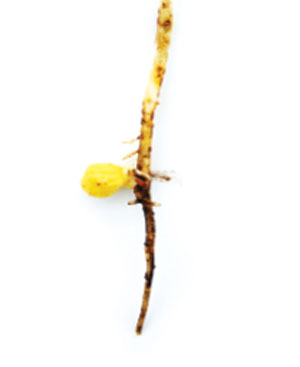The challenge
The major root disease of chickpeas in north-eastern Australia is Phytophthora root rot (PRR), which is caused by the fungus-like oomycete Phytophthora medicaginis. It can cause significant yield losses in wetter-than-normal seasons or following periods of soil saturation in normal seasons. The disease is especially widespread in the cracking clay soils of Queensland and New South Wales, where yield losses can exceed 40 per cent.
Moderate field resistance had been identified and incorporated in a range of chickpea (Cicer arietinum) varieties. The variety Yorker released in 2005 by the NSW Department of Primary Industries (DPI) had the highest level of PRR resistance of any Australian cultivar.
While this variety significantly reduced the impact of PRR, substantial crop write-offs and yield losses still occur under conditions highly favourable to disease development (namely high inoculum loads, on poorly drained soils that receive high rainfall).
Screening of the broader chickpea gene pool identified germplasm with superior resistance to PRR. However, this resistance was identified in a wild relative of chickpeas (C. echinospermum). While this species can be crossed with domesticated chickpeas in order to transfer the resistance into cultivated varieties, no genetic methods existed to select C. echinospermum-chickpea crosses with the best resistance.
A need was, therefore, identified for the development of new selection tools to support breeding for PRR resistance.
The response
 Good inoculation of rhizobia on chickpea plants. Photo: Pulse Australia
Good inoculation of rhizobia on chickpea plants. Photo: Pulse Australia
Between 2013 and 2019, GRDC investment targeted the gap in breeding tools required to reduce the economic costs to growers of PRR. The project was led by chickpea breeder Kristy Hobson at NSW DPI.
With the breeders unable to make selections in drought years due to low PRR disease pressure, alternatives to field-based phenotyping for disease resistance were needed. A non-field-based method was developed that successfully identified susceptible material. This was used in a selection process that reduced the number of lines that required field screening.
This screening work confirmed that C. echinospermum lines and crosses between C. echinospermum and chickpeas had the best resistance to PRR. A basis was also created to genetically map the source of this novel PRR resistance.
To best exploit the genetic map, genomic selection (GS) modelling was used to predict the parental selections needed to make the most genetic gain in this complex trait as quickly as possible. The project demonstrated that the improved GS approach has a higher prediction accuracy and flexibility compared to using traditional marker-assisted selection strategies alone.
The impact
The project successfully delivered improved resistance traits that are working their way through the variety development pipeline, with the promise of ongoing increases in the rate of gain in PRR resistance into the future.
The average annual yield gain attributed to the genetic improvement achieved through the life of this project has been estimated at 0.0007 tonnes per hectare for desi chickpeas and 0.0001t/ha for kabuli chickpeas. This amounts to average annual gains of $0.40/t and $0.07/t respectively.
The investment also contributed new knowledge and GS methods that have increased the effectiveness and efficiency of chickpea breeding. Importantly, the GS modelling approach has been adopted by chickpea breeding programs more broadly. This is a more cost-effective method to make selections and is expected to increase the rate of genetic gain for Australian chickpeas and reduce breeding cycle times, thereby accelerating variety development.
The value of these two impacts was estimated in monetary terms in a cost-benefit analysis performed by Sanaz Shoghi Kalkhoran and Talia Hardaker of ACRE Economics.
Total funding for the project was $3.29 million (present value terms) with a GRDC component of $1.79 million (present value terms). The investment generated future benefits estimated at a value of $9.11 million (present value terms) over 30 years using a 5 per cent discount rate. This gave a net present value of $5.82 million, a benefit-cost ratio of approximately 2.77 to 1, and an internal rate of return (IRR) of 14 per cent. Additional benefits achieved through this investment – but whose value was not monetised – include:
- increased average yields through the future release and adoption of new chickpea varieties with increased PRR resistance traits;
- increased profitability through an increase in the total average area of chickpeas grown (in rotation), with potential benefits to subsequent crop rotations from nitrogen fixation and other rotational benefits (such as weed break) due to more-reliable chickpea production levels;
- increased average profitability (reduced costs) for some Australian chickpea producers because of increased efficiency (cost‑effectiveness) of chickpea breeding programs adopting improved GS approaches;
- increased capital value of chickpea germplasm stocks for future research and incorporation into breeding programs through the improvement and maintenance of available germplasm;
- potentially, improved soil health and management due to better plant density and soil cover through reduced plant losses to PRR disease; and
- increased benefits to regional communities from enhanced producer incomes and increased chickpea infrastructure leading to higher regional economic activity and employment.
The economists noted that the estimated return on investment was likely to be an underestimate of the true performance of this project given that only two impacts were valued in monetary terms and the conservative assumptions made in the analysis.
More information: view GRDC’s Delivering impact case studies.

























































